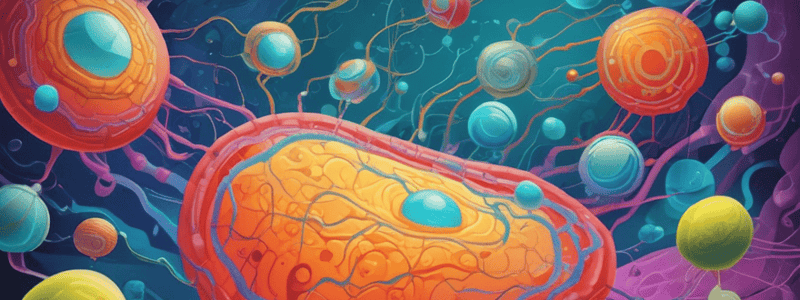Podcast
Questions and Answers
What is the role of mannose-6-phosphate in protein targeting to lysosomes?
What is the role of mannose-6-phosphate in protein targeting to lysosomes?
- It is an enzymatically active hydrolase
- It acts as a signal patch for protein folding
- It is involved in the sorting of proteins in the Golgi apparatus
- It serves as a recognition signal for M-6-P receptors (correct)
What is the purpose of the acidic environment in late endosomes?
What is the purpose of the acidic environment in late endosomes?
- To promote protein synthesis
- To release prohydrolases from M-6-P receptors (correct)
- To activate prohydrolases
- To facilitate vesicle fusion
In which organelle is the modification of the signal patch on a protein destined for a lysosome taking place?
In which organelle is the modification of the signal patch on a protein destined for a lysosome taking place?
- Lysosomes
- Golgi apparatus
- Endoplasmic reticulum (correct)
- Nucleus
What is the function of M-6-P receptors?
What is the function of M-6-P receptors?
Where are the prohydrolases activated by cleavage and removal of phosphate groups?
Where are the prohydrolases activated by cleavage and removal of phosphate groups?
What is the function of the TGN in the context of lysosomal enzyme trafficking?
What is the function of the TGN in the context of lysosomal enzyme trafficking?
What is the role of early and late endosomes in the context of lysosomal enzyme trafficking?
What is the role of early and late endosomes in the context of lysosomal enzyme trafficking?
What happens to secretory vesicles after they receive a neural stimulus?
What happens to secretory vesicles after they receive a neural stimulus?
What is the primary role of the Golgi apparatus in this process?
What is the primary role of the Golgi apparatus in this process?
What is the function of Rab-GTPase in vesicular trafficking?
What is the function of Rab-GTPase in vesicular trafficking?
What is the name given to secretory vesicles containing inactive precursor proteins?
What is the name given to secretory vesicles containing inactive precursor proteins?
What causes a transient influx of Ca2+ into the cytoplasm after a neural stimulus?
What causes a transient influx of Ca2+ into the cytoplasm after a neural stimulus?
What is the result of the interaction between v-SNAREs and t-SNAREs?
What is the result of the interaction between v-SNAREs and t-SNAREs?
What is the role of Ca2+ in this process?
What is the role of Ca2+ in this process?
What is the final step in the process of vesicular trafficking described?
What is the final step in the process of vesicular trafficking described?
What is not directly involved in the process of vesicular trafficking described?
What is not directly involved in the process of vesicular trafficking described?
What is the function of the Rab-GTPase activity in vesicular trafficking?
What is the function of the Rab-GTPase activity in vesicular trafficking?
Which protein family is responsible for target recognition in vesicular trafficking?
Which protein family is responsible for target recognition in vesicular trafficking?
What is the function of the NSF/α-SNAP protein complex in vesicular trafficking?
What is the function of the NSF/α-SNAP protein complex in vesicular trafficking?
What is the result of the tethering of the vesicle to the target membrane?
What is the result of the tethering of the vesicle to the target membrane?
What is the function of the adaptin complex in vesicular trafficking?
What is the function of the adaptin complex in vesicular trafficking?
What is the final step in the vesicular trafficking process?
What is the final step in the vesicular trafficking process?
What is the result of the interaction between the Rab-GTPase and tethering proteins?
What is the result of the interaction between the Rab-GTPase and tethering proteins?
What is the primary function of COP-I coated vesicles?
What is the primary function of COP-I coated vesicles?
Which type of vesicle is formed as a result of receptor-mediated endocytosis?
Which type of vesicle is formed as a result of receptor-mediated endocytosis?
What is the primary function of exocytosis?
What is the primary function of exocytosis?
What is the function of the constitutive pathway of exocytosis?
What is the function of the constitutive pathway of exocytosis?
Where are newly synthesized proteins initially delivered to after post-translational modification?
Where are newly synthesized proteins initially delivered to after post-translational modification?
What is the function of COP-II coated vesicles?
What is the function of COP-II coated vesicles?
What is the result of the fusion of a vesicle with a cytoplasmic organelle?
What is the result of the fusion of a vesicle with a cytoplasmic organelle?
Flashcards are hidden until you start studying
Study Notes
Vesicle Formation and Fusion
- Lipid rafts with cargo receptors initiate vesicle formation
- Clathrin coat assembly and adaptin complex formation occur, followed by budding of the fully assembled coated vesicle
- The coated vesicle travels to its destination, where the clathrin coat is disassembled, and the vesicle is tethered to the target membrane by Rab-GTPase and tethering proteins
- The docking process begins, involving the recruitment of tethering proteins and the formation of the cis-SNARE complex
- Fusion of the vesicle with the target membrane occurs, discharging the cargo protein into the early endosomal compartment
- v-SNAREs are recycled in the transport vesicles for use in another round of vesicle targeting
Endosomes and Lysosomes
- Some endosomes communicate with the vesicular transport system of the rER, providing constant delivery of newly synthesized lysosomal enzymes (hydrolases)
- Hydrolase synthesis occurs in the rER as an enzymatically inactive precursor (prohydrolase), which is then folded, glycosylated, and modified with a signal patch
- The signal patch is recognized by M-6-P receptors, which are present in early and late endosomes, lysosomes, and the Golgi apparatus
- The acidic environment of late endosomes causes the release of prohydrolases from the M-6-P receptors, which are then activated by cleavage and removal of phosphate groups
Early and Late Endosomes
- Early endosomes are found in the peripheral cytoplasm and fuse with cytoplasmic organelles
- Late endosomes are positioned near the Golgi apparatus and nucleus, and the acidic environment causes the release of prohydrolases
Exocytosis
- Intracellular traffic of vesicles is achieved by the presence of specific proteins (COATOMERS) on their surface, such as COP-I, COP-II, and others
- COP-II-coated vesicles deliver newly synthesized proteins to the Golgi apparatus
- Retrograde transport occurs between Golgi cisternae, mediated by COP-I-coated vesicles
- Two general pathways of exocytosis exist: constitutive and regulated pathways
Studying That Suits You
Use AI to generate personalized quizzes and flashcards to suit your learning preferences.




